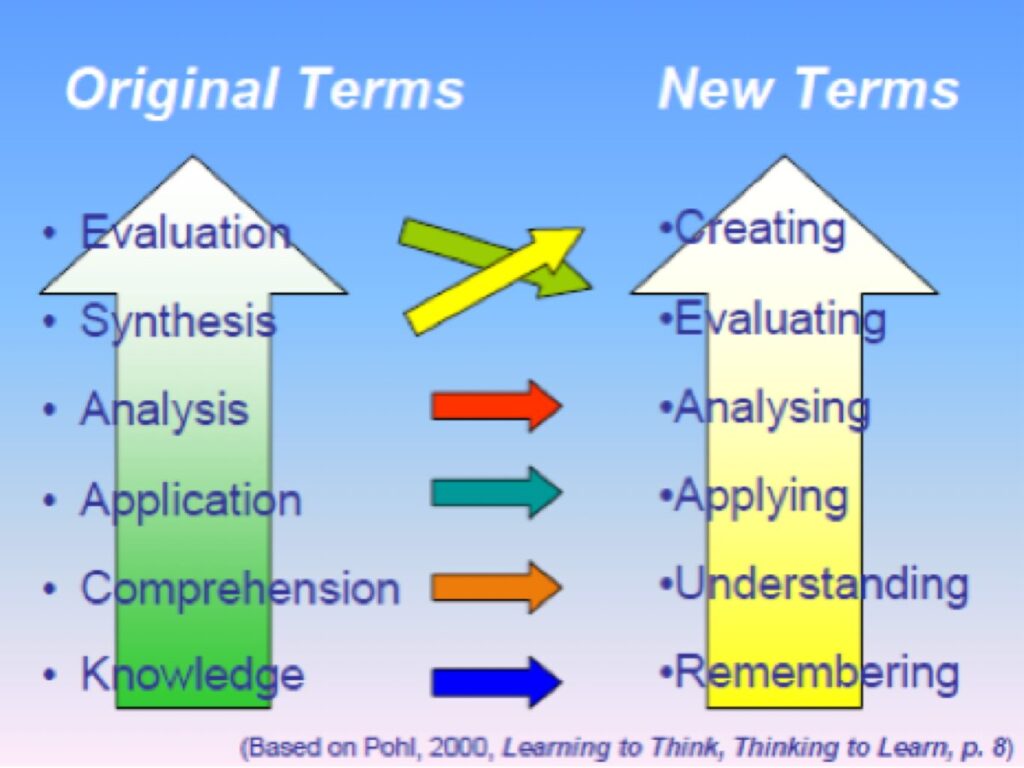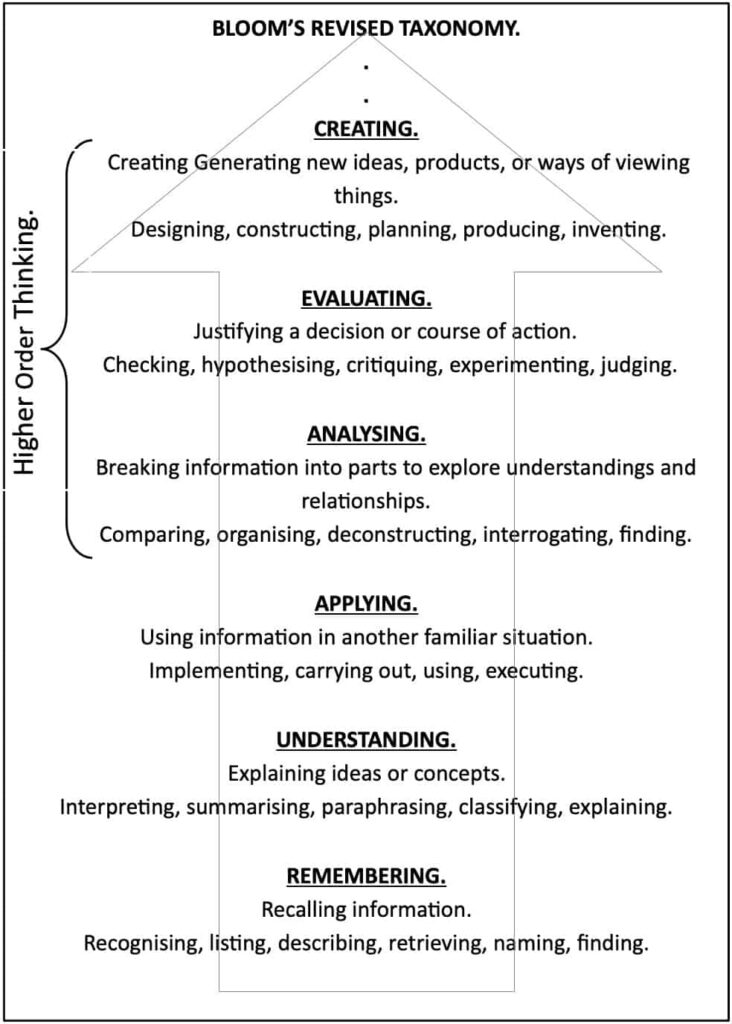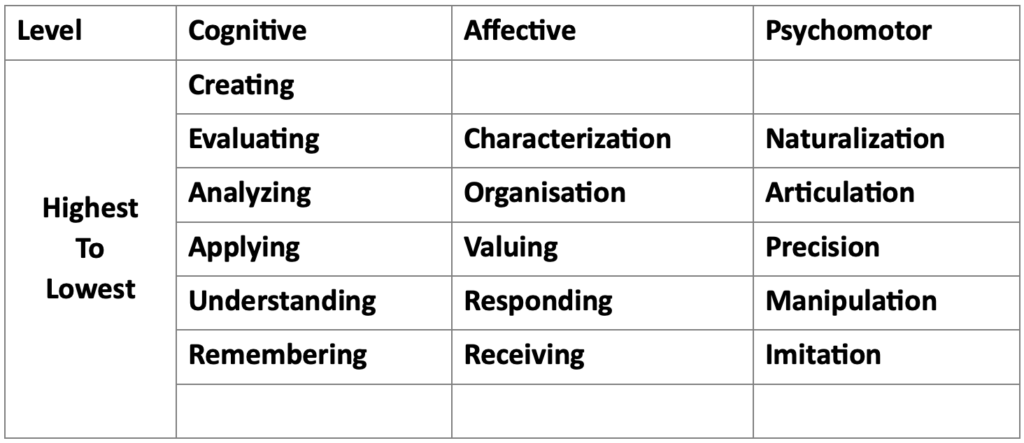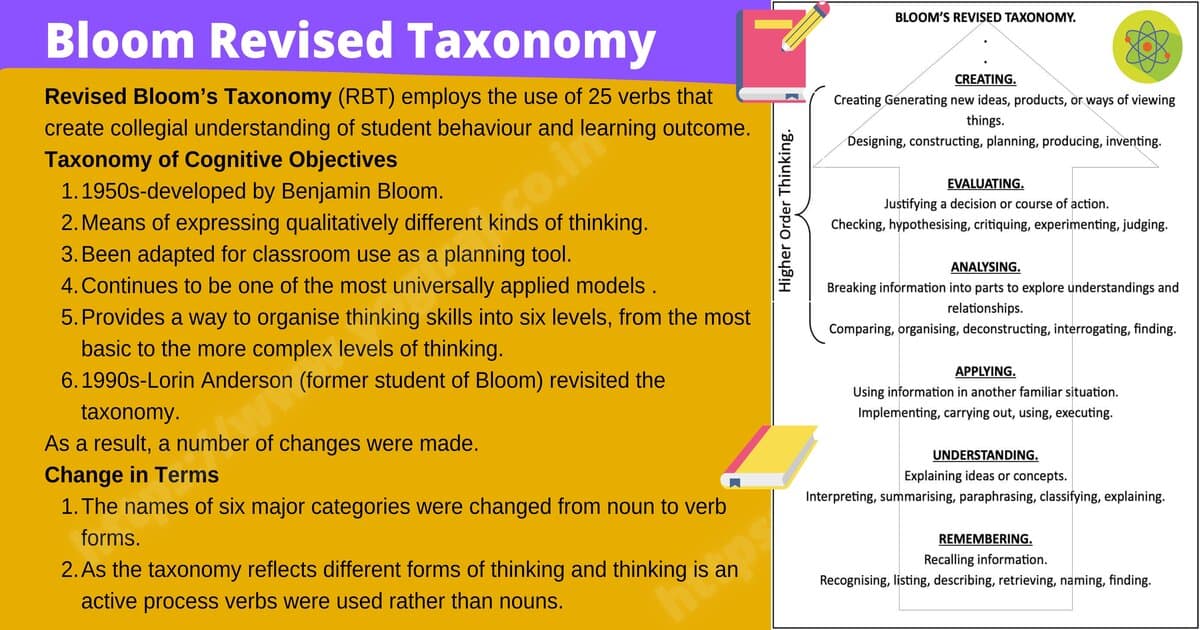Bloom Revised Taxonomy
by Yuvi - October 22, 2021
Bloom Revised Taxonomy
Revised Bloom’s Taxonomy (RBT) employs the use of 25 verbs that create collegial understanding of student behaviour and learning outcome.
Taxonomy of Cognitive Objectives
- 1950s-developed by Benjamin Bloom.
- Means of expressing qualitatively different kinds of thinking.
- Been adapted for classroom use as a planning tool.
- Continues to be one of the most universally applied models .
- Provides a way to organise thinking skills into six levels, from the most basic to the more complex levels of thinking.
- 1990s-Lorin Anderson (former student of Bloom) revisited the taxonomy.
As a result, a number of changes were made.

bloom revised taxonomy
Change in Terms
- The names of six major categories were changed from noun to verb forms.
- As the taxonomy reflects different forms of thinking and thinking is an active process verbs were used rather than nouns.
- The subcategories of the six major categories were also replaced by verbs and some subcategories were reorganised.
- The knowledge category was renamed. Knowledge is an outcome or product of thinking not a form of thinking per se. Consequently, the word knowledge was inappropriate to describe a category of thinking and was replaced with the word remembering instead.
- Comprehension and synthesis were retitled to understanding and creating respectively, in order to better reflect the nature of the thinking defined in each category.
Revised Bloom’s Taxonomy:

Bloom revised taxonomy summary
Cognitive Domain
1. Remembering-
Recognising or recalling knowledge from memory. Remembering is when memory is used to produce definitions, facts, or lists, or recite or retrieve material.
2. Understanding-
Constructing meaning from different types of functions be they written or graphic messages activities like interpreting, exemplifying, classifying, summarising, inferring, comparing, and explaining.
3. Applying-
Carrying out or using a procedure through executing, or implementing. Applying related and refers to situations where learned material is used through products like models, presentations, interviews or simulations.
4. Analysing-
Breaking material or concepts into parts, determining how the parts relate or interrelate to one another or to an overall structure or purpose. Mental actions included in this function are differentiating, organising, and attributing, as well as being able to distinguish between the components or parts.
5. Evaluating-
Making judgments based on criteria and standards through checking and critiquing. Critiques, recommendations, and reports are some of the products that can be created to demonstrate the processes of evaluation.
6. Creating-
Putting elements together to form a coherent or functional whole reorganising elements into a new pattern or structure through generating, planning, or producing. Creating requires users to put parts together in a new way or synthesise parts into something new and different a new form or product.
Affective Domain –
This domain constructs a comprehensive outline of a person’s affective or emotional abilities dealing with attitudes, values, interest, appreciation, etc. It has 5 major categories –
1. Receiving –
Here, willingness of the learner to receive is important – whether he is sensitive to certain stimuli and whether or not he is willing to receive the stimulus. Eg. A pupil reads a notice of an essay contest.
2. Responding –
The learner feels involved and motivated to respond, gets satisfaction from the activity and attaches emotional significance to it. Eg. The pupil is interested, applies for the contest and prepares for it.
3. Valuing –
The learner’s behaviour is sufficiently consistent and stable wherein he has accepted a value, shows commitment to a certain idea, goal, belief or viewpoint and conviction or preference for it. Eg. The pupil is mostly always willing to participate in any essay contest.
4. Organisation –
This level organises values into priorities. Conflicts between values are resolved and inter-relationships are established. Eg. Pupil shows a liking for essay as well as debate contests but prefers the essay.
5. Characterisation –
The learner’s behaviour is consistent, predictable and becomes his characteristic or nature. He has finally integrated his beliefs and this forms the general philosophy of his life. Eg. Teacher and pupil know he is a better writer than speaker.
Dave’s Psychomotor (Behavioural) Domain
Category or ‘level’ –
1. Imitation-
Behavior Descriptions:- Copy action of another; observe and replicate.
Examples of activity or demonstration and evidence to be measured:- Watch teacher or trainer and repeat action, process or activity .
2. Manipulation-
Behavior Descriptions:- Reproduce activity from instruction or memory.
Examples of activity or demonstration and evidence to be measured:- Carry out task from written or verbal instruction .
3. Precision-
Behavior Descriptions:- Execute skill reliably, independent of help, activity is quick, smooth, and accurate.
Examples of activity or demonstration and evidence to be measured:- Perform a task or activity with expertise and to high quality without assistance or instruction; able to demonstrate an activity to other learners .
4. Articulation –
Behavior Descriptions:- Adapt and integrate expertise to satisfy a new context or task.
Examples of activity or demonstration and evidence to be measured:- Relate and combine associated activities to develop methods to meet varying, novel requirements.
5. Naturalisation –
Behavior Descriptions:- Instinctive, effortless, unconscious mastery of activity and related skills at strategic level
Examples of activity or demonstration and evidence to be measured :- Define aim, approach and strategy for use of activities to meet strategic need
Conclusion
Dr. Bloom’s taxonomy is hierarchical in nature because it moves from the simple to the complex, from the concrete to the abstract. As the learner progresses, each category becomes more complex and more abstract than the previous category thus leading to increase in the power of his abilities












